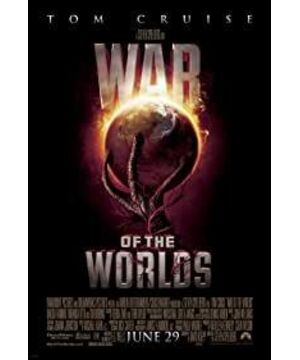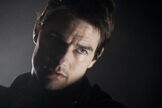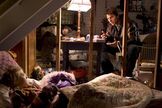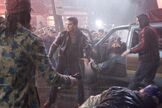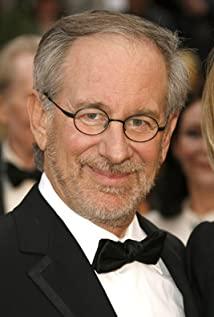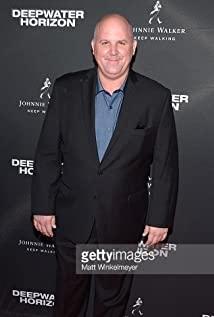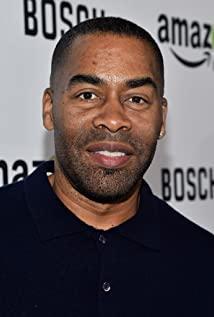After the movie was released, some people said that the ending was too hasty, and the wonderful ending is here. This is not a war between humans, nor a war between humans and aliens, but a war between creatures in the entire universe. The final The winner is the earth, the law of nature. Aliens launched a war of aggression against mankind, in fact they launched a war against the earth, and it was the earth that won the victory in the end, which has nothing to do with mankind. In fact, at the beginning of the film, the war has already begun, and the microorganisms on the earth have launched a counterattack against the alien invasion.
In my impression, Spielberg is a director who uses film technology very artistically, especially this "War of the World". Some people say how small the scene of this movie is, how hasty the ending is, the appearance of aliens is average, and the plot is mediocre. However, what I like most is the photography technique of this film.
One of the characteristics of the director’s mirroring in this film is the use of mirror reflection to shoot, or picture-in-picture. Many of the pictures you see in the film are seen in another picture, for example, the DV screen reflects the alien machine. Breaking out of the ground, the windows of the house and the rear windshield of the car are used to reflect people's horrified expressions and the machine's ground-breaking movements, so that multiple scenes can be represented in one scene. TV screens and car rearview mirrors use mirror-reflected objects to shoot. Simply put, you can see both the front and the back. For example, on a DV screen, you can see the outside of the back. For the star machine, you can also see the crowd fleeing in front of the display screen. Or in the rearview mirror of a car, you can see the person behind chasing, and you can also see the person in front. This kind of practical expression is close to reality, and the director likes to use it in this film.
In addition, this film uses long shots many times. For example, it starts with a moving long shot, moving from the panoramic view of the port city to the working environment of the male protagonist. Many movies use this way, and the effect is to introduce the audience into the movie as soon as possible. . The director uses a lot of long shots instead of fast editing (similar to "Saving Private Ryan", Old Si style). I think the work of the editor must be very easy, and the work of the photographer will be much harder. There are many shots that combine real scenes with special effects, so the special effects are also very exquisite. I personally think that except for the special effect where Tom’s house was stepped on by the alien machine, I think it’s a bit fake. nature.
Before analyzing the long shots, let’s take a look at a wonderful shot. The camera rotates 360 degrees inside the car. I don’t know where the camera is. This is when Rachel’s family just got on the car, they used another rotating lens. It shows the characters inside and outside the car. The space inside the car is very small. I really don’t know how it was shot. Is it a small camera + a large wide angle?
The following is only a segmented analysis of the two long shots in the film:
There is a long shot from 26'55 to 27'54, and the duration is one minute:
26'55: A woman's face appears on the screen
26'58: Woman's face Split (killed)
27'00: The hero appears in the crowd and runs
27'03: The hero enters the clothing store with the crowd
27'12: A car is turned into the store
27'13: The protagonist comes out of the clothing store ( At this time, there are two human figures passing in front of the camera, most of the camera is blocked, here should be a transition, the back should be another shot, but in terms of time and the continuity of the scene, this is a long shot the stitching techniques)
27'15: lens left shaking and move to the back, a man ran in front of the camera
27'19: screen actor back to the right point of view, the camera shake to the upper right corner, cut into the screen to show the effects house was destroyed
27'21 : The camera pans back, the middle shot, the actor keeps running
27'23: The camera pans to the upper left corner, cutting into the special effects screen to show the house is destroyed
27'25: The camera pans back, the actor looks back, and the picture of the destroyed house outside the screen is
drawn on the right 27'28: The actor moves back and sticks to the front of the camera
27 '32-35: The camera
moves to the right, the hero hides behind the wall 27'35-43: The camera shakes up and then left, the alien machine walks from right to left from the screen
27'44-48: The camera shakes again Shaking left, the father holding his daughter walks from right to left in the screen
27'48-52: The camera is pushed forward, the disaster scene and the male protagonist each occupy half of the screen, and the camera ends.
This shot was taken in real scene + green screen, divided into two shots (before and after leaving the clothing store), and later cut into a coherent shot.
The longest long lens is when driving for a while. It’s wonderful. You can hardly feel it is a long lens, because it uses a full 360-degree angle and has no dead ends. Although I still don’t know how it was taken, let’s talk about my guess:
driving for a while, the most classic long shot in the whole film is between 32'04-34'33, and the duration is two and a half minutes (only the movement of the lens is analyzed, not Discuss the position of the actors) A
large number of cars are parked on the road, and a car is drawn from the left.
32'03: This shot starts from the back of the main car, rotates to the left from the low position, and pushes forward quickly following the main car. , Three cars passing through the foreground (this long lens always keeps moving fast in the direction of the main vehicle during the movement, and will not be exhausted later)
32'06: The lens rotates to the right. There are three more cars passing through the foreground, of which the camera was blocked by the car when passing the third car at 32'09 and it just crossed the flyover. The camera was completely black. I guess this should be a transition. The real shot ends (also It may indeed be coherent with the back)
32'11: The camera turns to the right side of the main car and continues to turn right to the front of the car. The picture shows that the three people are discussing in the car.
32'
32'31: The camera moves right to the left middle window of the main car, and the son comforts his daughter.
32'35: The camera keeps rotating right and enters the car from the left rear window (the rear window is open), and the son teaches his daughter how to relax. The 32'43 lens is then moved out of the car from the rear window on the right side of the main car. How this lens is done is very puzzling. Guess 1: When the photographer stretched the camera into the car from the left side of the car, another person from the right side of the car took the camera over, and the whole process kept moving smoothly. But the main vehicle is moving fast, which is too difficult. Guess 2: When the camera pans into the car, the rear door of the car opens (it is the kind of door that folds upwards), and another photographer enters the rear of the car, takes the camera from the left side of the car, and completes the shot through the car. , Then hand the camera from the right to the photographer on the right side of the car. The whole movement can also be done with a rocker arm, but it is much more difficult.
32'44: After the camera is panned out, it continues to shift to the right. The close shot shows the son comforting his daughter and the discussion
between the son and the actor. 33'12: After the camera is pulled to the middle shot, three cars
passing through the foreground 33'16: The camera quickly rotates to the right On the left side of the car, the four cars
passing through the foreground 33'21-34'19: Push forward the camera and rotate left to the front of the car, and move slightly left and right. The close-up shows the father-son dialogue and the three-person dialogue
34'20, after the camera is moved to the right , Sway to the left and rise to the top of the back of the car, pulling it into a panoramic view, showing that the main car continues to drive on the road, and the shot ends.
Some people on the Internet have discussed that this shot may not have been taken in a moving car, but that the car was parked in front of a green screen and shot with post-production special effects. This is indeed possible, but I think it is still real shot, but the scene scheduling is very difficult. When shooting close-up shots, there may be several camera cars around the main car (cooperating with the movement of the camera inside and outside the car), and when the lens is pulled to the middle or panoramic view, the camera car ran out of the screen again, and the whole The speed of the main car in the shot is not very fast, but the director arranges several scenes through several cars from time to time and uses low camera positions. It feels like the car is driving very fast, and the other cars in the whole scene are all It is not moving. The driving route of the main vehicle is well-designed. It is easy to get familiar with the walking position after a few more trips. It is also relatively wide. Some of the actions that seem to be Sassafras cars are actually the illusion that the camera’s telephoto section gives people the illusion that the car in the foreground is photographed. It is said that the director used 16 cameras when filming the scene on the highway. Department, it’s impossible to just take a few panoramic shots to show that there are many people on the road. It must be used for this long lens.
Some people say that this film is not as good as "Independence Day", "World War" and "Independence Day" are separated by 9/11. The superiority of the masters of the old and beautiful world is gone. It is more of crisis and panic. I don't like it. People of "World War" must have watched "Independence Day" and admired it very much. There are also many people on the Internet discussing which scene in the film is the most terrifying. Although some people mentioned that the scenes of many alien attacks are horrible, but the most talked about is the car robbing section. The car robbing section is a very real expression of the character’s psychology. The most primitive savage humanity in the kind of despair.
In short, I think this movie is good, and some details have been handled well, but Laos seems to have too high expectations for this movie (but he was clamoring to break the box office record of the Titanic). In fact, the box office is also Not bad, the world is more than 500 million (but the cost is as high as more than 200 million), the sequel is not expected, it depends on what new actions he has to do next.
-----------------------------------------------
Supplement: After It was confirmed by the production special that the long shots of driving for a while were stitched together after the green screen shooting.
View more about War of the Worlds reviews


